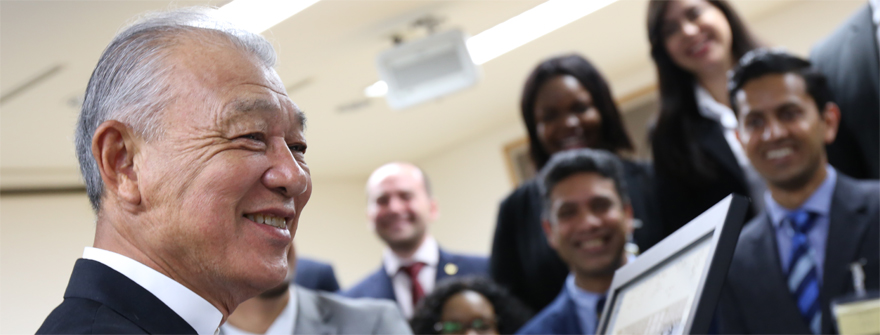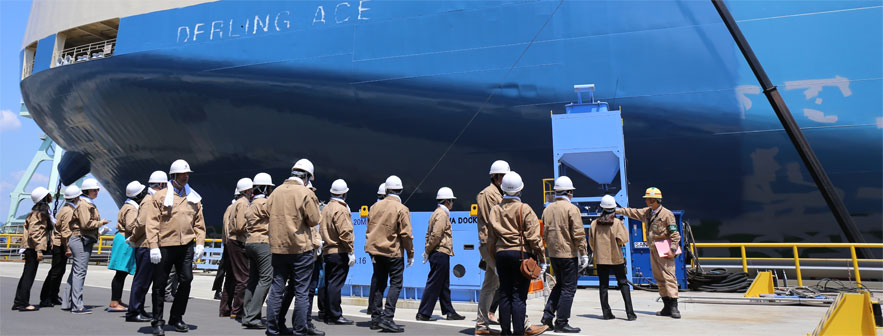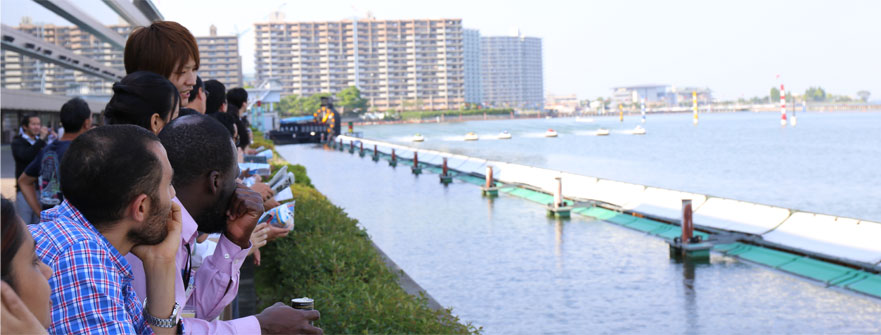Japan Field Study Trip
Japan Field Study Trip 2017
Saturday-Sunday, May 13-14
The much anticipated field study trip to Japan began with 27 students, the largest group to date in the WMU Sasakawa Fellowship Programme, meeting at Triangeln train station on Saturday just before noon.Everyone generously helped each other with boarding and check-in before we got our direct flight from Copenhagen to Tokyo.It was a smooth journey, although there were some bleary-eyed students when we arrived at Narita International Airport on Sunday morning.It was lovely to be greeted there by the familiar face of Mr. Shinichi Ichikawa, and to be introduced to our expert guide for the week, Ms. Miyoko Wada, whom we would all come to appreciate greatly. We boarded a coach directly and were greeted at the beautiful Sasakawa Peace Foundation Building by Mr. Eisuke Kudo, a friend of WMU since it was established in 1983, an Honorary Fellow, and WMU Governor.
After a brief orientation about the week ahead, we enjoyed our first lunch together, which gave everyone the opportunity to unwind, visit, and catch up with Mr. Kudo and Mr. Ichikawa before heading to our hotel. After check-in, we had our first free evening in Tokyo. For most of the students, this was their first trip to Japan and they were excited to get out and explore. Within our group were two Japanese Sasakawa Fellowship students, Mr. Kazuhisa Takumi and Mr. Yuki Morimasa, who throughout the trip were willing to lead groups out to explore their home country. Many of the students took advantage of that first evening to get a good sense of Tokyo and were very appreciative of the extra assistance from Mr. Takumi and Mr. Morimasa in navigating the Tokyo subway system as well as menus in Japanese.
Tokyo, May 15
Monday was a full programme that began with a visit to the Hydrographic and Oceanographic Department of the Japan Coast Guard. Japan was the first country to publish electronic navigational charts, and it was fascinating to learn about the work the Department is undertaking regarding safety of navigation and conservation of the marine environment.Following lunch, we had our much anticipated courtesy visit with Dr. Yohei Sasakawa. Prior to his arrival, Mr. Hiroshi Terashima, Executive Director of the Sasakawa Peace Foundation and former WMU Governor told us a bit about the extraordinary maritime history and geography of Japan, with 6,852 islands and the Seto Inland Sea that we would get to see later in the week.
When Dr. Sasakawa arrived, each student had the opportunity to introduce themselves and thank him for his generosity in making their studies at WMU possible. Ms. Johana Paola Solorzano Ardon from Honduras delivered heartfelt thanks on behalf of the students, noting their appreciation for being part of the Sasakawa Fellows Network and what it will mean for their own careers, as well as for the global maritime industry through capacity building within their nations.
Dr. Sasakawa addressed the students, highlighting his philosophy on philanthropy and ocean research. We then had the opportunity to present Dr. Sasakawa with a framed photo of the students, with each of their signatures and country of origins in the margin. A photo together and singing the WMU song concluded our visit. Everyone was so appreciative of the time with Dr. Sasakawa.
The afternoon programme continued with a visit to the Maritime Bureau at the Ministry of Land, Infrastructure, Transport and Tourism (MLIT) where Mr. Ichiro Hao, Director-General of the Maritime Bureau, welcomed the students. An informative presentation about the Ministry and maritime policy in Japan was delivered by Mr. Yo Shibata. On behalfof the students, Mr. Mark Philip Cassar from Malta delivered thanks for the honor of visiting the Ministry.
The day concluded with a welcome reception at the Tokai University Club in the Kasumigaseki Building, with stunning views of Tokyo from the 35th floor. Welcome remarks were made by Mr. Terashima, and a toast by Mr. Hao as a start to a lovely evening of socializing. We were touched that so many senior representatives of The Nippon Foundation, MLIT, Japan's maritime industry, and WMU graduates were at the event to welcome us. Mr. Roger Mengistu Teah from Liberia warmly delivered thanks on behalf of the students, conveying how privileged they felt not only to be Sasakawa Fellowship students, but also to have a once-in-a-lifetime opportunity to visit Japan, with a behind-the-scenes look at the country’s impressive maritime industry.
Yokohama and Tokyo, May 16
An horn's bus ride from our hotel, the first visit on Tuesday's programme was to the JXTG Nippon Oil & Energy Negishi Refinery, which is surprisingly located next to a residential area in Yokohama. An impressive presentation high-lighted their high ethical standards and commitment to health, safety and the environment. We appreciated the opportunity for a bus tour around the facilities.The day's programme concluded back in Tokyo with a visit to the Shin-Koto Incineration Plant. It provided a fascinating look into the efficiency and technology behind waste management in such a large city, and we were all fascinated by the cranes transferring refuse to the incinerators. We were also excited to catch a view of Mt. Fuji in the distance.
Matsuyama, May 17
We departed our Tokyo hotel on Wednesday morning, bound for Haneda Airport. Our 90-minute flight to Matsuyama provided us with an incredible view of the Seto Inland Sea that separates three of the four main islands of Japan. Looking out the window, it was easy to understand how Japan is made up of 6,852 islands! It was stunning to see beautiful, small, lush islands dotting the deep blue waters.The one stop on our agenda for the day was Miura Co. Ltd., Japan's leading boiler manufacturer. After an informative presentation, we had the opportunity to tour the factory floor and see ballast water management systems and incinerators in manufacture. Miura's environmentally-conscious focus was impressive, as well as the precision and technology involved in their manufacturing. It was dear by the many questions from the students that they found the visit informative and fascinating.
After arriving at our hotel in Matsuyama, many students took advantage of the free evening to visit Dogo Onsen, one of Japan's oldest and most famous hot springs. Mr. Kudo led the group on the outing that was complete with Japanese robes and sipping green tea within the beautiful traditional Japanese architecture.
Innoshima and Osaka, May 18
We boarded the bus early on Thursday morning and headed to the Sanwa Dock Co., Ltd., on Innoshima, where we were welcomed enthusiastically by President and CEO, Isamu Teranishi. The impressive family-owned company specializes in ship lifecycle maintenance and is dedicated to craftsmanship and advanced technology. After a presentation about the company, we had the opportunity to walk around the shipyard and maintenance areas and were impressed by the apparent skill and attention to detail.After our visit, we boarded the bus and headed to Shin-Onomichi Station for our first ride on a bullet train. While we were waiting on the platform, we were lucky to see the yellow Shinkansen test train that is used to check the high speed train system in Japan. It is considered good fortune to see "Dr. Yellow" as it is often called, especially since its schedule is not made public. Our first ride was a quick 10 minutes to Fukuyama Station, where we boarded a second train and enjoyed a smooth, 60-minute ride to Shin-Osaka with lunch on the train.
Boarding a bus, we headed to the Port of Osaka. Mr. Akira Sakai provided us with an interesting presentation about the port, which supports 21 million people in its hinterland. It is the fifth largest port in Japan in terms of container cargo, with 94% of volume from Asian countries. This year the port is celebrating 150 years, so it was a treat to then take a boat tour and see the beautiful city of Osaka from the water.
Kobe, May 19
Our first full day in Kobe began with a visit to the Marine Technical College. We were met by former WMU Professor, Mr. Toshio Hikima, Mr. Kiyoshi Maeda, and the Rector, Mr. Reiji Tanabe. After graciously explaining the College's core role in educating and training seafarers in Japan and Asia, we divided into groups, and several faculty members led us on tours of the facilities. The students were particularly impressed by the simulators and appreciated the opportunity to ask questions about the curriculum and its scope.After lunch, we were treated to a visit at Kawasaki Heavy Industries, Ltd., that was only made possible by permission of the Ministry of Defense. Following a presentation about the company, we went on a partial tour of the factory facilities. It was incredibly interesting to visit the birthplace of Kawasaki industries, a company with a long and distinguished history. Kawasaki is one of the few companies in the world that can produce a ship or submarine in its entirety, so it was a pleasure to visit their impressive facilities.
Our day rounded out with a quick stop at a Shinto shrine, where we had a chance to do a traditional cleansing ritual. We then attended a reception hosted by the Japan Ship Machinery and Equipment Association (JSMEA), an intermediary between parties engaged in maritime affairs. Representatives from several companies were in attendance, including the Nakashima Propeller Company, which donated the propellor that stands outside the WIVIU building. The students made many valuable connections, and the evening concluded with the students singing the WMU song.
Kyoto, May 20
Our final day in Japan, we were treated to cultural visits in Kyoto, the former capital, starting with the Toji Buddhist temple, which is a UNESCO World Heritage Site. We marveled at the incredible architecture and beauty of the gardens. We then continued to another UNESCO World Heritage Site, the Buddhist Kiyomizu-dera Temple, picturesquely perched on a hillside. At this celebrated temple, many students took advantage of the opportunity to drink from the Otowa Waterfall's pure waters, which are purported to promote longevity. It was a beautiful walk down the hill through the gardens.After lunch, everyone was excited about going to the boat races in Biwako. We were treated to VIP seats and had the opportunity to place two bets - there were even some winners in the group! Mr. Yaser Bayoumy Abdelwahab Farag from Egypt delivered words of thanks on behalf of the students for the opportunity to see where the funding for the Sasakawa Fellowship Programme comes from, and for the continued support of maritime capacity building worldwide.
Our week concluded with a lovely farewell reception attended by many of the representatives we had met in Kobe, friends of the Sasakawa Peace Foundation, WMU graduates and many well-wishers. It was a lovely opportunity to reflect on the incredible week behind us and thank the many people who had contributed to the planning and success of our visit. Ms. Abigail Yanique Bryan from Jamaica delivered heartwarming remarks on behalf of the students, thanking our hosts for a once-in-a-lifetime experience and opportunity that would leave a lasting impression. We sang the WIVIU song for the last lime in Japan.
Departure, Sunday, May 21
It was very early in the morning as we headed to Kansai International Airport. It had been a whirlwind week with 12 extraordinary field study visits. We had experienced the stunning beauty of Japan from air, land and sea, and were so grateful for the warm hospitality and generosity we experienced at every location. Our sincere thanks are extended to The Nippon Foundation for their generosity, as well as SPF, MLIT, our site visit hosts, and all who were involved in arranging our exceptional programme. A very special thanks is extended to Mr. Kudo, Mr. Ichikawa and Ms. Wada for accompanying us all week and making us feel at home.It was clear during our time together that this group of students is forging the bonds that are intended to be created among Sasakawa Fellows to strengthen not only the maritime industry, but also to fundamentally make the world a better place. In November, these 27 students will graduate and return to their home countries. They will carry with them the educational and cultural knowledge they gained at WIVIU, as well as the connections and experiences as Sasakawa Fellows that will not only benefit them professionally and personally throughout their lives, but also the lives of the people who surround them. Japan will forever be in their hearts, and in mine as well.
Maia Brindley Nilsson
Communications Officer
World Maritime University






